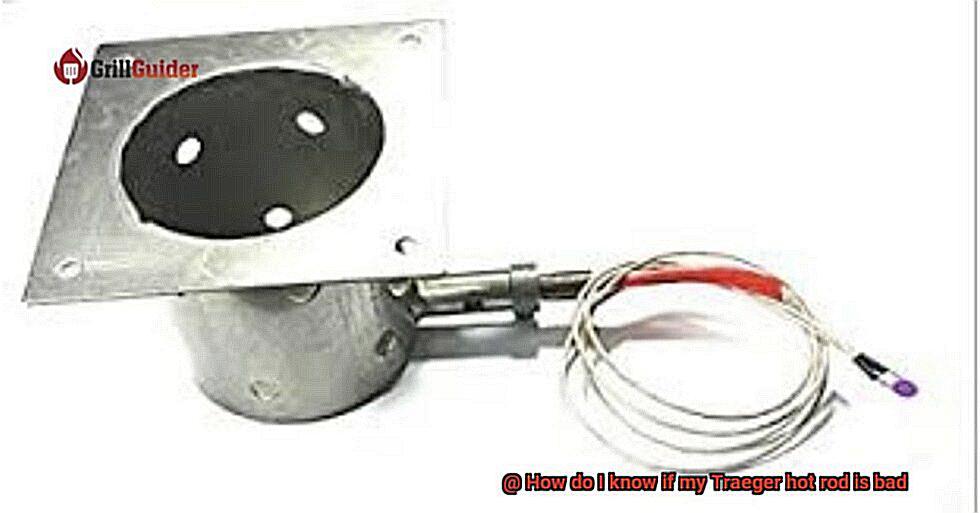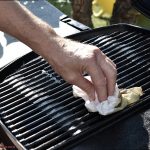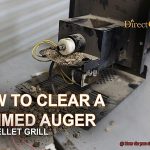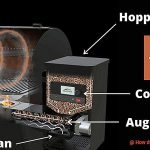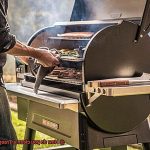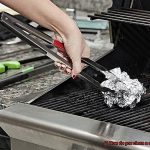As a proud owner of a Traeger grill, you understand the critical role the hot rod plays in your cooking experience. It’s responsible for igniting those wood pellets that infuse your meats with that smoky flavor you crave. But what happens when your hot rod goes bad?
You may have noticed that your grill isn’t heating up as it should or you’re having trouble keeping it lit. These are telltale signs that your hot rod is on its last legs. Unfortunately, a failing hot rod can seriously impact your grilling game, leaving you with undercooked meat or an inconsistent temperature.
Don’t let a bad hot rod ruin your grilling experience. This blog post will provide all the information you need to detect if your hot rod is causing issues and how to fix it. We’ll dive into the symptoms and causes of a failing hot rod and discuss the steps to take to replace it.
Grilling isn’t just about cooking food; it’s a way of life. And we know how important it is to keep your Traeger grill in top-notch condition. So, let’s explore how to identify a bad hot rod and get back to grilling those mouth-watering ribs and steaks without any hiccups.
Contents
What is a Traeger Hot Rod?
A Traeger Hot Rod is a heating element that sits inside the firebox of your pellet grill. It’s responsible for igniting the wood pellets that produce heat and smoke necessary for cooking food. Essentially, the hot rod acts as a match to start the grill’s fire. Without it, your grill won’t be able to produce heat or smoke, which are crucial components of any delicious meal.
The hot rod is made up of several key parts: a heating element, a protective metal tube, and a metal tip. The heating element is made up of a coil of wire that heats up when electricity runs through it. The protective metal tube shields the heating element from moisture and other elements that could damage it. The metal tip is what comes into direct contact with the wood pellets to ignite them.
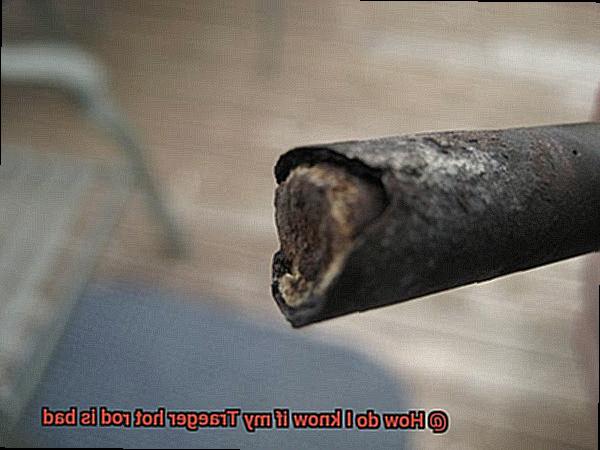
However, over time, the hot rod can wear out or become damaged due to exposure to high temperatures or moisture. When this happens, it may not be able to heat up properly or may fail altogether, leading to difficulty starting the grill or maintaining consistent temperatures during cooking.
So how do you know if your Traeger hot rod needs replacing? There are a few telltale signs to watch out for. If your grill struggles to reach or maintain consistent temperatures, this could be an indication that the hot rod is not heating up properly. You may also notice a lack of smoke or flavor in your food, as the hot rod ignites the wood pellets that produce both.
Another sign that your hot rod may be bad is if you notice a buildup of ash in your grill’s firepot. This could indicate that the hot rod is not heating up enough to burn off excess pellets and ash, leaving them to accumulate in the firepot.
If you’re experiencing any of these issues with your Traeger grill, it’s time to take action and replace your hot rod. A new hot rod will ensure that your grill is back to producing perfectly cooked meals every time. Remember, the hot rod is a crucial component of any pellet grill. Understanding how it works and how to identify when it needs to be replaced will ensure that you’re always able to produce delicious meals for yourself and your loved ones.
Signs of a Bad Traeger Hot Rod
It’s responsible for starting and maintaining the fire that cooks your food to perfection. Therefore, it’s crucial to recognize the signs of a bad Traeger hot rod.
If you’re having trouble starting your grill, it’s a clear indication that something is wrong with the hot rod. A faulty hot rod struggles to ignite the pellets, leading to difficulty starting the grill. Additionally, if your grill takes longer than usual to heat up or doesn’t reach the desired temperature, it could be due to a bad hot rod. An inefficient hot rod won’t maintain the required temperature, resulting in slower heating times.
Another sign of a bad hot rod is inconsistent temperature while cooking. If you notice that your grill’s temperature fluctuates frequently during use, it could be due to a faulty hot rod struggling to maintain a consistent temperature. This can lead to uneven cooking results and ruin your meal.
Furthermore, an excessive amount of ash buildup inside the firebox is another sign of a bad hot rod. A faulty hot rod doesn’t fully ignite the pellets, leading to incomplete combustion and more ash buildup in the firebox.
If you inspect your hot rod and notice that it’s burned out or has visible damage, it’s time for a replacement. A burned-out hot rod won’t be efficient and won’t work effectively in igniting pellets.
Lastly, regular maintenance of your grill can prevent such issues from occurring in the first place. Check and clean your hot rod regularly to keep it working efficiently.
Difficulty Reaching or Maintaining Temperature
Don’t give up just yet. The problem may lie with a faulty hot rod. The hot rod is responsible for igniting the pellets and maintaining the temperature inside the grill. If it’s not functioning properly, it can lead to undercooked or overcooked meat.
To check if your hot rod is the issue, start by inspecting it for physical damage or wear and tear. If it looks good, you can perform a continuity test using a multimeter. Simply unplug the grill and remove the hot rod from the firepot. Set your multimeter to the continuity setting and touch one lead to the threaded portion of the hot rod and the other lead to the metal bracket on the end of the hot rod. If there’s no continuity, then it’s time for a replacement.
A bad hot rod can make it difficult to maintain a consistent temperature, but there are ways to work around it. You may need to manually light the pellets using a torch or lighter and keep an eye on the temperature throughout your cooking process. However, this requires more effort and attention on your part.
To avoid this hassle altogether, make sure to regularly inspect your hot rod for any signs of damage or wear and tear. This will ensure that it’s functioning properly and help you achieve optimal grilling results every time.
Lack of Smoke or Flavor in Food
As a grill master, nothing is more disappointing than biting into a piece of meat that lacks the smoky flavor you crave. It’s like a letdown after all the time and effort put into preparing your meal. But did you know that a lack of smoke or flavor in your food could be an indicator that your Traeger hot rod is bad?
The hot rod is the beating heart of your Traeger grill, responsible for igniting the pellets that create the smoke that infuses your food with flavor. A malfunctioning hot rod can affect more than just the taste of your food. It can also cause other problems with your grill, like making it harder to reach and maintain the correct temperature.
So, how do you know if your hot rod is bad? Here are some telltale signs: visually inspect it for any signs of wear and tear, such as rust or damage to the wires. If you notice any damage, it’s probably time to replace your hot rod. You can also listen for a clicking sound when you turn on the grill – if there’s no sound, this could indicate that the hot rod is not working correctly and needs to be replaced.
Don’t forget to pay attention to the temperature of your Traeger grill. If it takes longer than usual for the grill to reach your desired temperature or doesn’t get as hot as it used to, this could be a sign that your hot rod is failing. Ignoring these signs will only lead to further disappointment in your grilling experience.
Replacing the hot rod may seem intimidating, but it’s a relatively simple process that can be done at home with basic tools. Just follow the manufacturer’s instructions and take all necessary safety precautions. Don’t let a faulty hot rod ruin your grilling experience – take action and replace it today.
Buildup of Ash in the Firepot
A buildup of ash in the firepot can cause issues with your hot rod and hinder your grilling experience. But don’t worry; checking and cleaning the firepot is easy and essential for maintaining your grill’s performance.
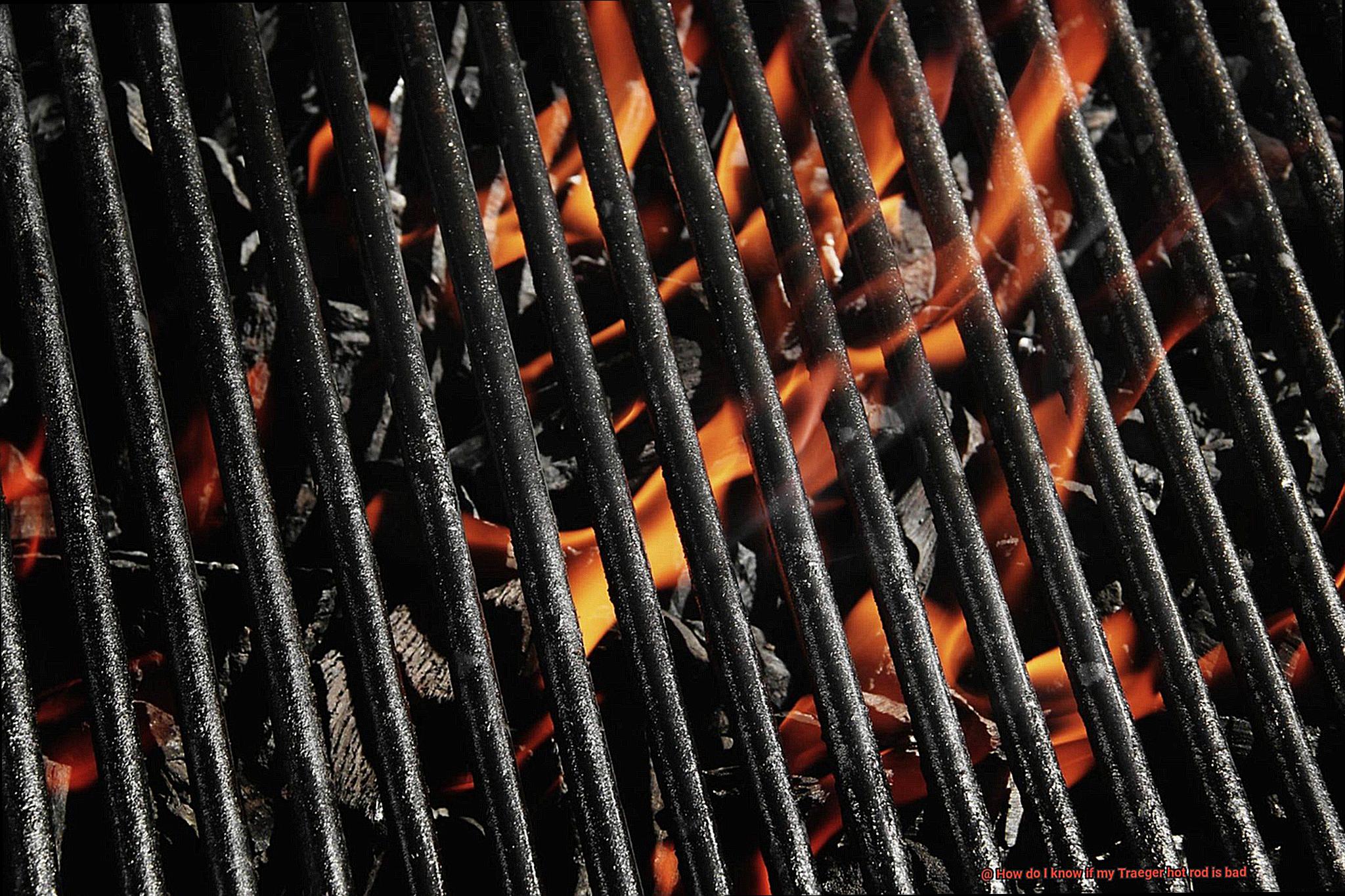
To start, safety first. Turn off your Traeger and let it cool down completely. Once it’s cool, remove the grates from the cooking chamber and take a peek inside the firepot. If you notice a significant amount of ash buildup, it’s time to clean it out.
Cleaning out the firepot is a breeze with a shop vac or any vacuum designed for ash removal. You can also use a wire brush or scraper to remove stubborn bits of ash. Just remember to wear gloves and eye protection while you’re at it.
Regularly cleaning out the firepot is crucial for maintaining your Traeger grill’s temperature control and pellet ignition. Aim to clean it out after every few cooking sessions, especially if you notice any issues.
But why stop at the firepot? Keeping your Traeger grill clean overall is key to enjoying perfectly cooked meals. Here are some additional maintenance tips:
- Empty the grease bucket after every use to prevent grease fires and keep your grill clean.
- Clean the cooking grates before and after each use to avoid food sticking and ensure even heat distribution.
- Check the hopper for any debris before adding new pellets to prevent clogs.
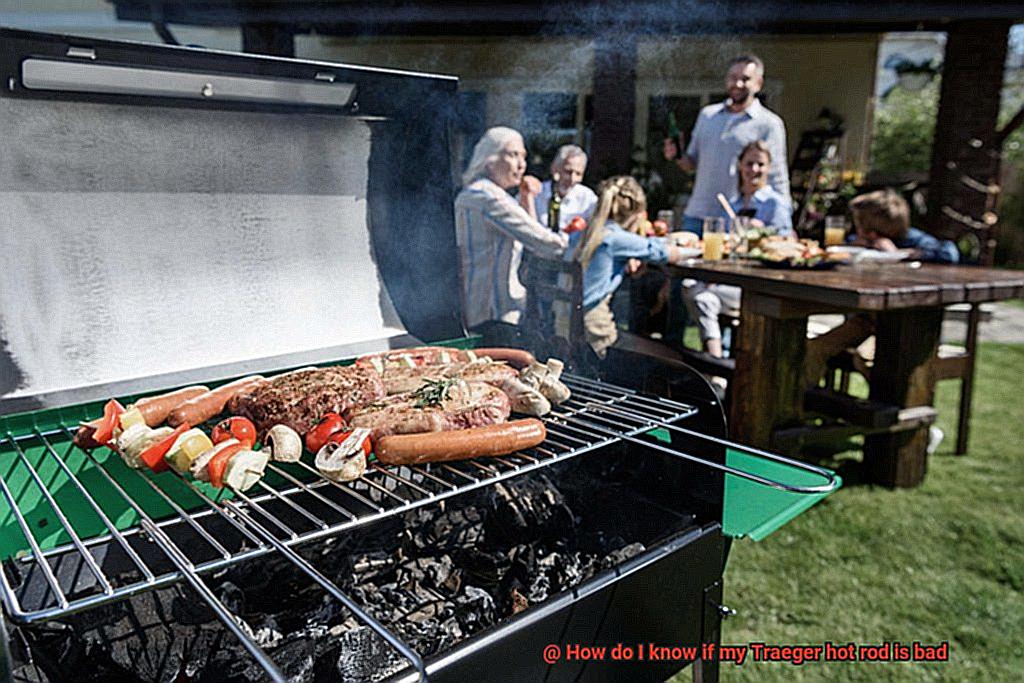
How to Diagnose and Replace a Bad Hot Rod
Diagnosing and replacing a bad hot rod in your Traeger grill is essential to ensure optimal performance. A hot rod ignites pellets to create heat for cooking, and if it’s not functioning correctly, your grill won’t ignite and you won’t be able to cook. In this article, we’ll go over five sub-sections on how to diagnose and replace a bad hot rod in your Traeger grill.
Signs of a Bad Hot Rod
The first step in diagnosing a bad hot rod is to look for signs that indicate it’s time for a replacement. The most common sign is a lack of heat. If you notice that your grill is no longer reaching the desired temperature or takes longer than usual to get there, then it’s likely that the hot rod is not functioning properly. Another sign of a bad hot rod is an uneven temperature distribution. If you notice that some parts of your grill are hotter than others, it could be a sign that the hot rod is failing to heat up evenly. Additionally, if you hear strange noises or notice unusual sparks when you turn on your grill, it could be an indication of a faulty hot rod.
Visual Inspection
The first step in diagnosing a bad hot rod is performing a visual inspection. Start by unplugging your grill and removing the grates and drip tray to access the hot rod. Look for any signs of damage or wear and tear, such as cracks or discoloration. If everything looks intact, then it’s time to move on to testing the hot rod’s functionality.
Testing the Hot Rod
To test your hot rod, turn on your grill and watch for any signs of heating. A healthy hot rod will turn bright red within a few minutes of being turned on. If you don’t see any color change or if the hot rod takes longer than usual to heat up, then it’s likely that it needs to be replaced.
Replacing the Hot Rod
Replacing a bad hot rod is relatively easy and can be done in a few simple steps. Start by unplugging your grill and removing the old hot rod from its socket. Then, insert the new hot rod into the same socket and secure it in place. Finally, reattach the grates and drip tray and plug in your grill to test its functionality.
Common Causes of Hot Rod Issues
Don’t panic just yet. There are common causes of hot rod issues that you should know to help diagnose and fix any problems with your grill.
First on the list is a damaged or broken hot rod. The hot rod is an essential component that ignites the pellets to create the perfect smoky flavor. However, over time, wear and tear or exposure to moisture can damage the hot rod. If you’re experiencing difficulty igniting your grill or slower heating than usual, it’s possible that your hot rod is broken and needs replacement. Thankfully, replacing the hot rod is a straightforward process that you can do at home with minimal tools.
Another culprit behind hot rod issues is a faulty fuse or circuit breaker. If your grill suddenly stops working and won’t ignite, check the fuse or circuit breaker to see if it’s tripped. Reset it and try igniting your grill again. However, if the fuse or circuit breaker keeps tripping, you may have an electrical issue that requires professional attention.
Lastly, a dirty or clogged hot rod can also cause issues with your grill. Dirt, grease, and other debris can build up on the hot rod over time, causing it to malfunction. To avoid problems with your hot rod, be sure to clean it regularly using a soft brush to remove any buildup.
Tips for Maintaining Your Traeger Grill and Hot Rod
Maintaining your Traeger grill and hot rod is crucial to ensuring that it remains in top-notch working condition. Neglecting your grill can lead to uneven cooking, poor flavor, and even complete failure of the appliance. Here are some tips for maintaining your Traeger grill and hot rod:
Clean Your Grill Regularly
Cleaning your grill after every use is essential to keep it in good working condition. The build-up of grease, ash, and debris can clog up your hot rod and other components of your grill. Use a grill brush to clean the grates and a scraper to remove any stubborn debris. Also, clean the grease tray and remove any debris from the firepot.
Check Your Hot Rod Regularly
The hot rod ignites the pellets and starts the fire, so checking it regularly is vital. Turn on your Traeger grill and listen for the igniter to click. If you don’t hear a clicking sound, it may be time to replace your hot rod. Inspect the wiring on your hot rod for any signs of wear or damage, too.
Keep Your Grill Covered
Sun, wind, rain, or snow can cause damage to your grill and its components, including the hot rod. To prevent this from happening, it’s essential to keep your grill covered when it’s not in use. A cover will protect your grill from environmental factors and extend its lifespan.
Use High-Quality Pellets
The quality of pellets you use has a significant impact on the performance of your Traeger grill and hot rod. Low-quality pellets can leave behind excess ash and debris, which can clog up your hot rod and other components of your grill. Using high-quality pellets will help ensure that your grill runs smoothly and efficiently.
Replace Your Hot Rod When Necessary
Like any other component of your grill, the hot rod can wear out over time. If you notice any signs of wear and tear, such as cracks or breaks in the element, it may be time to replace the hot rod. A faulty hot rod can cause uneven cooking temperatures or even prevent your grill from starting altogether.
4lP06ukb_68″ >
Conclusion
In conclusion, a Traeger hot rod is the unsung hero of your grilling experience. It’s responsible for igniting the wood pellets that produce heat and smoke, which are essential for cooking food to perfection. A failing hot rod can lead to disastrous consequences, such as undercooked meat or inconsistent temperature control. Therefore, it’s crucial to understand the signs of a bad hot rod and how to replace it.
The telltale signs of a bad hot rod include difficulty reaching or maintaining temperature, lack of smoke or flavor in food, and buildup of ash in the firepot. Fortunately, regular maintenance can prevent these issues from arising in the first place. By cleaning out the firepot after every few cooking sessions, you’ll ensure that your Traeger grill maintains its temperature control and pellet ignition.
Replacing a bad hot rod is relatively easy and can be done at home with basic tools. However, it’s essential to know common causes of hot rod issues so that you can diagnose and fix any problems with your grill effectively. To keep your Traeger grill in top-notch condition, clean it regularly, check your hot rod frequently, cover your grill when not in use, use high-quality pellets, and replace your hot rod when necessary.
By following these tips and understanding how to identify a bad hot rod, you’ll be able to produce perfectly cooked meals without any hiccups. Don’t let a faulty hot rod ruin your grilling experience – take action and replace it today.

